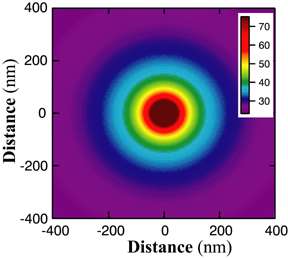Gold Nanoparticles Prove to Be Hot Stuff

Gold nanoparticles are highly efficient and sensitive “handles” for biological molecules being manipulated and tracked by lasers, but they also can heat up fast—by tens of degrees in just a few nanoseconds—which could either damage the molecules or help study them, according to scientists at JILA, a joint institute of the National Institute of Standards and Technology (NIST) and University of Colorado at Boulder.
Biophysicists often study nanoscale and even picoscale mechanics by using lasers to both apply force to and track the position of fragile biomolecules such as DNA or protein by manipulating a tiny sphere—typically polystyrene—attached to the molecule. The JILA team would like to find new microsphere materials that can be trapped by laser radiation pressure more efficiently, which would enable faster measurements and detection of smaller motions at the same laser power.
As described in the Aug. 15 issue of Optics Letters, the JILA team demonstrated that 100-nanometer-wide gold beads, as expected because of their metallic nature, can be trapped and detected six times more easily than polystyrene particles of a similar size.
However, the scientists also found that gold absorbs light and heats up quickly, by a remarkable 266 degrees (Celsius) per watt of laser power, at the wavelength most often used in optical traps. Unless very low laser power is used, the heat could damage the molecules under study. Thus, gold beads would not be useful for temperature-sensitive experiments or applying force to molecules. But the heating effect could be useful in raising local temperatures in certain experiments, such as heating a protein just enough to allow scientists to watch it unfold, the paper suggests.
The work was supported by a W.M. Keck grant in the RNA Sciences, a Burroughs Wellcome Fund Career Award in the Biomedical Sciences, a National Institutes of Health training grant, the National Science Foundation, and NIST.
Citation: Y. Seol, A.E. Carpenter, T.T. Perkins. 2006. Gold nanoparticles: enhanced optical trapping and sensitivity coupled with significant heating. Optics Letters. Aug. 15.
Credit: NIST





















